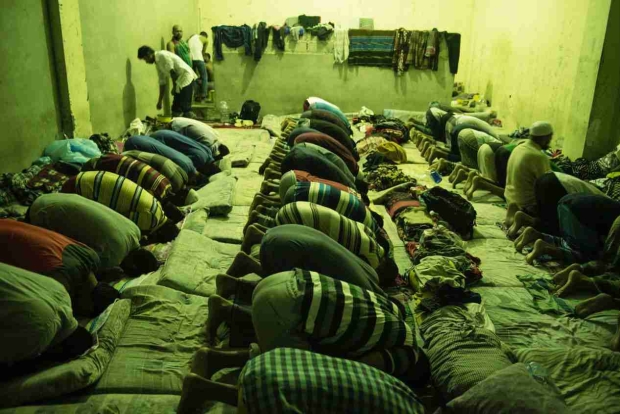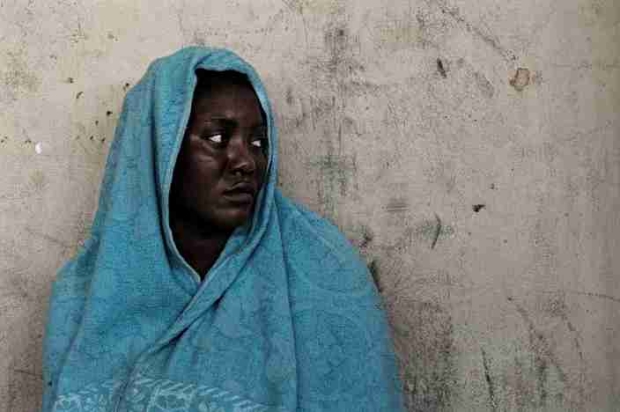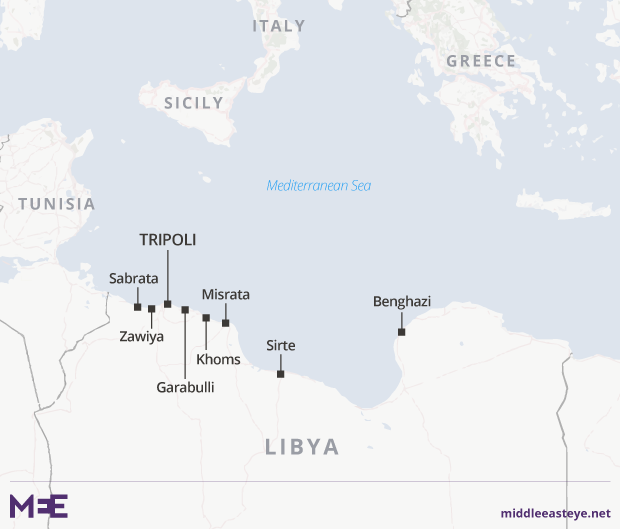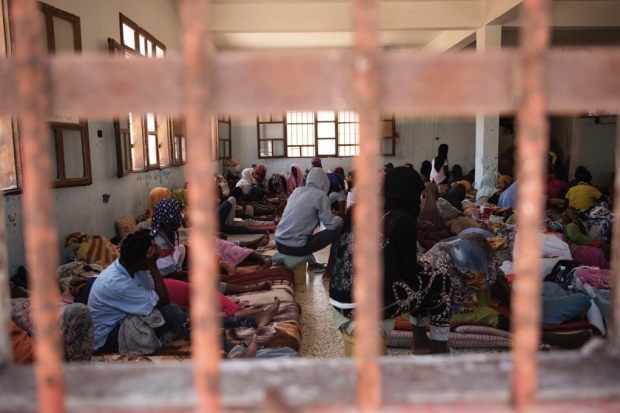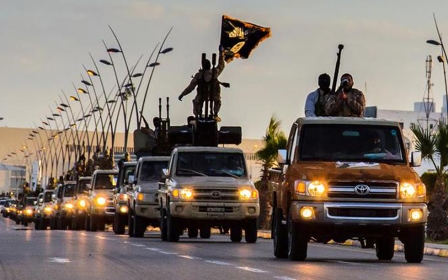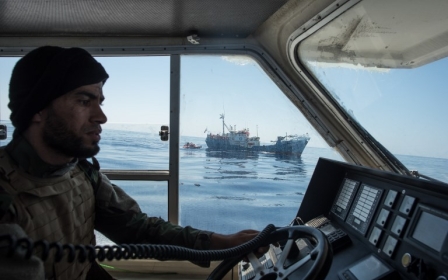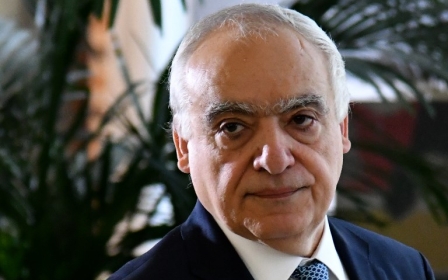They can't sail for Europe - so what's happening to migrants trapped in Libya?

The Surman detention centre, home to hundreds of desperate refugees, is nothing more than a concrete block.
It sits near a secondary road in western Libya, some 60 kilometres from Tripoli and close to Sabrata and Zawiya, two cities whose wealth is now built on illegal oil trafficking.
A guard stands outside the single padlocked door, the only entrance to the official facility. He refuses to give his name amid fear for his own safety but agrees to give Middle East Eye access.
Next to each mattress there are a few items, including soap and combs. Some of the prisoners may have an extra shirt. Many have nothing.
Jandra, in her mid-20s, escaped from poverty in Ivory Coast to seek out a better future in Europe. She was already at sea off the Libyan coast with 120 other people when the engine on their rubber boat failed. Soon they were picked up by the Libyan coastguard, then arrested.
She recalls that the group were first taken to an official centre in Zawiya. “There were 1,200 of us, stacked in hundreds in each room,” she says. “We were so tight that we could not lie down, we had to take turns to sleep."
'We were so tight that we could not lie down, we had to take turns to sleep'
- Jandra, Ivory Coast migrant
Jandra says that the guards inside the centre took everything they had: shoes, shirts, phones and, of course, money.
“Once we were inside the detention centre, they started to blackmail us. They used the phones they had taken away to contact our friends in Libya and ask for money in exchange for our release or else directly called our relatives, threatening to kill us if they did not find a way to send money."
Jandra’s story is increasingly common among migrants who sail from Libya’s shores, seeking a better life – but then find themselves back in the country, caught amid a chain of violence and threats.
A hell of violence and exploitation
Libya has become the preferred destination for migrants and refugees heading for Europe. In the first half of 2017, at least 2,030 people died or went missing while crossing the Mediterranean for southern Europe. The greatest number set off from Libya.
The EU, and especially Rome, has tried to work with the Libyan authorities to return migrant ships back to North Africa.
Previous investigations by Middle East Eye revealed that armed Libyan groups are receiving payoffs to stop boats leaving Libya, in exchange for aid, aircraft hangars and money.
But what happens to those people once they are returned to shore?
Laura Thompson of the International Organisation for Migration told AFP on Wednesday that there “are somewhere around 31 or 32 detention centres, and around half are controlled by, or are in the areas controlled by, the government”. She said that nobody knew how many people were being kept in the facilities, where conditions were "extremely bad”.
A day earlier the UNHCR said that it was “opposed to the routine detention of refugees and displaced persons and has been very outspoken, including at the highest level, on the appalling conditions in which refugees and migrants are being held in Libya’s detention centres”.
But then there are the illegal facilities, directly run by armed militias involved in human trafficking and fuel smuggling, often with the complicity of members of the coastguard service.
No one can put an exact number on how many rogue centres there are: interior ministry officials do not approach the areas controlled by the militias as they are too dangerous.
Male captives are frequently beaten until they can somehow get relatives to send more money to Libya, or else set to work in factories or oil refineries. Women may end up being trafficked sexually.
According to a UNICEF report released in February, "detention centres run by militias are nothing but forced labour camps, armed robbery prisons. For thousands of migrant women and children, prison is a hell of rape, violence, sexual exploitation, hunger, and repeated abuses."
Ahmed, a policeman, is too scared to give his real name. He tells MEE: "There are dozens and dozens of prisons over which we have no control, including at least 13 in Tripoli, run by powerful armed militias.
“Here in Tripoli, one of the most powerful militia involved in human trafficking and the control of illegal detention centres is the Sharikan. No one can approach the areas they control. We have no power over these prisons, we cannot get close to them because we risk being killed."
How migrants are exploited
In Tripoli, Abdrazaq Alshneti, an officer at the department responsible for combating illegal migration, says that some of the official centres it runs are collapsing because there is not enough money nor aid.
"Europeans think the problem in Libya is politics,” he says, “but we cannot build a government of national unity without a national army."
One official in the same office is prepared to say more than Alshneti dares, albeit on condition of anonymity for his own safety.
Ibrahim – not his real name - says that in recent months, before the agreement between the UN-backed government of Libyan Prime Minister Fayez al-Sarraj and Europe, detention centres overflowed with detained migrants.
“When the centres are overflowing, migrants are taken out, there is no money to feed them all,” Ibrahim says. “Some guards are good people, but some of them are corrupt.”He hints at the tangled relationship which exists between centre personnel, smugglers, militia and human traffickers, which pass desperate migrants between themselves like a resaleable human commodity.
The guards at detention centres may take money from the traffickers, then hand the migrants over.
Or smugglers tip off the coastguard when their migrants are due to sail to Europe so that they will be captured and passed to militias.
Or militias will seize migrants in the streets on the grounds that they do not carry the necessary documentation, a requirement in Libya. “They pretend to arrest illegal migrants and then keep them in their centres without food and water, take their money, exploit them, abuse women,” Ibrahim says.
Immigrants are also transported to the Garabulli area, midway between Misrata and Tripoli, to manage the rubber boats for fresh migrants - with the complicity of coastguard employees.
The coastguard has repeatedly denied that its members are involved in the people-trafficking trade.
But a UN report has found that:
"Abuses against migrants were widely reported, including executions, torture and deprivation of food, water and access to sanitation. The International Organisation for Migration also reported enslavement of sub-Saharan migrants. Smugglers, as well as the Department to Counter Illegal Migration and the coastguard, are directly involved in such grave human rights violations."
Ahmed says that, during the past few months, there have been clashes in several official detention centres between interior ministry officials and the militias who wanted to occupy them by force.
For example, one official centre in the Garabulli region was burnt to the ground by a militia in March. No one knows where the migrants went.
That same month, Middle East Eye visited the official centre in Khoms in March. From outside it looked like a squat mass of cement in the middle of nowhere: step inside and the smell was unbearable.
Inside the cells were overcrowded, the ground floor littered with dirty blankets and around 200 migrants sleeping 10 or 15 in a room of all but a few square metres. In the men's section water drains were broken and the human waste covered half the floors.
And now? Nothing. The centre is shut. And no one could explain where those 200 people had gone.
An orphan called Bright
In a corner of a large room at the centre in Surman, a woman known only as Happiness clutches a month-old baby boy. "His mother died a week ago," says the guard.
Happiness approaches. She is crying.
"I come from Nigeria,” she says. “I ran away because I needed to help my family, I needed to work. I promised them that once I arrived in Europe I would have done my best, but now I've been here for three months. And now I have to take care of Bright, as I promised her mother while she was dying.” Bright’s father died before he was born.
Happiness says that her friend became ill after Bright was born but received no medical aid. “Now her body is in the nearby hospital. It can’t be sent back to her family. She lost her documents at sea, and her family does not have the money to send the corpse.”
Sometimes the guard brings milk for Bright and other newborns, but aid in Surman is rare and the women have to rely on each other.
During the past six months, six children have been born in Surman's detention centre. No doctor has visited the women, the children or the newborns. A guard says it is “for security reasons, because Libya is very dangerous”.
A group of Nigerian women in their 20s approach.
"Help us," the say.
"Tell our loved ones that we are alive."
"Bring something to eat for our children."
Where have the people gone?
A few kilometres away is the Al Nasr centre, which serves as the official facility for Zawiya. When departures were at their height during the early summer, it housed more than 2,600 people. But when MEE visited, that number had dropped to around 1,000.
A guard opens one of the cells. John, from Gambia, approaches and talks in a low voice. He is afraid to be heard.
"When people like you arrive here, the guards open the cells and pretend to treat us well,” he says. “But as soon as you go away they beat and blackmail us. Only the ones who can pay are let free.”
He is joined by Phil, also from Gambia. Others have been held for up to eight months.
“They use us as slaves, and when we are no longer needed, they throw us away,” he says. "Humanitarian organisations do not come here. Sometimes some locals come to us with soap and bread. But no international."
One of the reasons why humanitarian organisations do not visit centres such as Zawiya is that it - like many others in Libya - is considered too dangerous.
In June, a five-vehicle convoy belonging to UNSMIL, the UN mission in Libya, was attacked by militias 30 kilometres west of Tripoli. The kidnappers demanded the release of three suspected drug dealers arrested by the Rada Special Deterrence Force in Tripoli. NGOs have urged more protection against the militia - but security measures have yet to have any lasting impact.
Back in Al Nasr, around 150 women are clustered in the female section. One of them, Princess, a Nigerian, gave birth 15 days ago to twins. Her husband was taken to another prison when he was captured: no one knows which one. Princess does not know how to find him; nor does he know that he is now a father of two.
'If war does not kill you, hunger will kill you, and here we are prisoners, the same hell. It's worth trying to cross the sea again'
- Princess, Nigerian migrant
Princess spends her days lying on a dirty mattress on the ground, beside her two babies. They do not have nappies nor barely enough drinking water.
She too crossed the Sahara, this time to escape Boko Haram. She was determined that her children would not grow up afraid, fearing every day that they would die.
"I do not care if they [the coastguards] have stopped me, I will try again," she says, looking at her newborn children. "I know it's dangerous. Nigeria is also dangerous. If war does not kill you, hunger will kill you, and here we are prisoners, the same hell. It's worth trying to cross the sea again.”
Princess has yet to learn: she will be lucky to escape Libya.
This article is available in French on Middle East Eye French edition.
Middle East Eye propose une couverture et une analyse indépendantes et incomparables du Moyen-Orient, de l’Afrique du Nord et d’autres régions du monde. Pour en savoir plus sur la reprise de ce contenu et les frais qui s’appliquent, veuillez remplir ce formulaire [en anglais]. Pour en savoir plus sur MEE, cliquez ici [en anglais].


